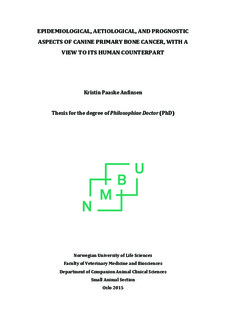Epidemiological, aetiological and prognostic aspects of canine primary bone cancer, with a view to its human counterpart
Doctoral thesis
Permanent lenke
http://hdl.handle.net/11250/2447836Utgivelsesdato
2017-07-05Metadata
Vis full innførselSamlinger
- Doctoral theses (VetMed) [129]
Sammendrag
Osteosarcoma (OSA) is the most common histological subtype of primary bone cancer in both humans and dogs. The importance of this relatively rare malignancy in humans is underlined by the fact that it typically affects children and adolescents, constituting about 5% of paediatric cancers (<15 years (y) of age). Although a rare disease in the canine population as well, certain breeds of dogs have a lifetime risk approaching 10%, thereby
affecting a large proportion of these dogs. Hence, OSA has a major impact on the health within such breeds. The overall incidence rate in canines outnumbers that of the human population, inspiring the use of dogs with naturally occurring OSA as models for its human counterpart. Furthermore, similar clinical and epidemiological features of this disease are seen in the 2 species. Knowledge regarding risk factors for developing OSA is scarce in both dogs and humans. A better understanding of the aetiology and pathogenesis could generate ideas for novel treatment options, and identifying markers for progression of the disease may help optimise individualised therapy. Osteosarkom (OSA) er den vanligste histologiske formen for primær benkreft hos både mennesker og hunder. Viktigheten av denne relativt sjeldne kreftformen understrekes av at den hovedsakelig rammer barn og ungdom; den utgjør omtrent 5 % av kreftsykdommene som rammer barn under 15 år. Osteosarkom er sjelden hos hunder også, men rammer opp til 10 % av hunder innen visse raser i løpet av livet. Sykdommen får derfor store konsekvenser for helsen til disse rasene. Alt i alt er OSA vanligere hos hund enn menneske, noe som har ført til bruk av hunder med naturlig forekomst av OSA som modeller for tilsvarende sykdom hos mennesker. Dette komparative aspektet styrkes av kliniske og epidemiologiske likheter ved denne kreftformen hos de to artene. Kunnskap om risikofaktorer for utviklingen av denne sykdommen er mangelfull hos både hund og menneske. En bedre forståelse av årsaksfaktorer for utvikling av OSA kan generere hypoteser som fører til nye behandlingsformer, samt identifisere markører som kan indikere progresjon av sykdommen og tilrettelegge for individuelle behandlingsprotokoller.
